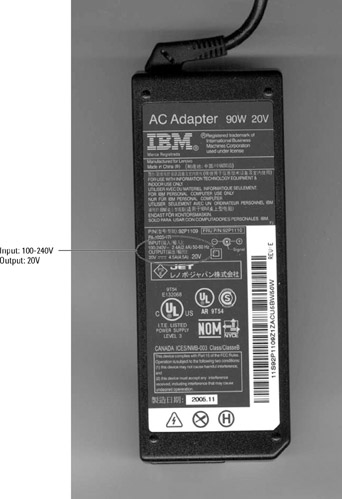Power Supplies for Laptop Computers
Power supplies for most laptop computers are divided into two sections: an external power unit that converts AC house current to DC (most often either 12 volts or 20 volts), and a separate circuit inside the computer that drops the incoming DC power to the lower DC voltages that the electronic and mechanical components require. The internal power supply can take power from either the computer's internal battery or an external DC power unit. When the external power unit is connected to a laptop computer, it charges the internal battery at the same time that it provides power to the computer.
This approach provides several benefits for a portable machine. First, it reduces the weight of the computer by moving the power unit to a separate package that you can leave behind when you're operating the computer on the internal battery, and it also moves a significant source of heat away from the other components.
The label on an external power unit shows much of the same information as the internal power supply inside a desktop computer. As Figure 20.6 shows, the label identifies the AC input voltage and the DC output voltage, along with the maximum amount of power the unit can handle.

Figure 20.6: A laptop computer's power unit provides DC current to run the computer and charge the battery.
| Caution | Don't try to use a power unit with the wrong voltage or a lower maximum current rating than the values specified for your laptop; the computer doesn't work properly with too little power. Too much power can damage the internal circuitry. |
EAN: 2147483647
Pages: 372